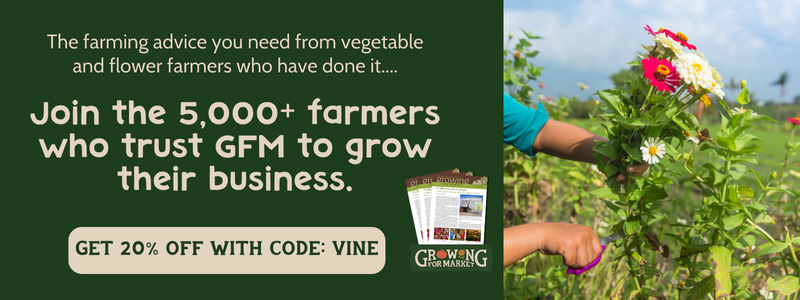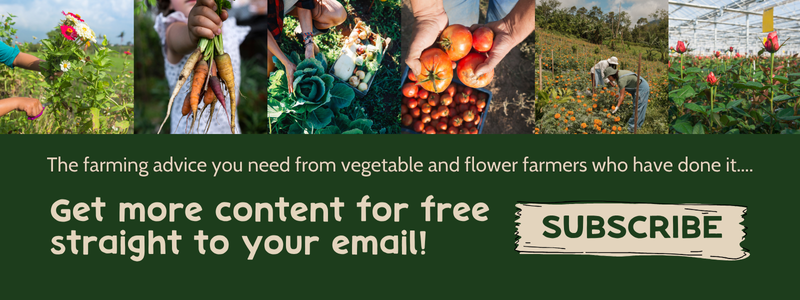Our farm is in Flanders, in northern Belgium. Belgium is a small country, about the size of Maryland, with a population of 10 million people. Depending on traffic, it takes about 2 hours to drive through the country from the Netherlands, in the north, to France in the south. Or about 3 ½ hours from the coast on the North Sea to either Germany or Luxembourg in the east.
The Flemish radio traffic report pretty much covers all of Flanders in one report. While Belgium is very densely populated, the cities tend to be smaller than in the United States and urban and agricultural land tends to be more interwoven. We farm close to Leuven, a small city of 100,000 inhabitants.
Within a 10-kilometer circle around Leuven, there are six CSAs, with five of us operating as self-harvesting farms. We are all certified organic, and the combination of direct sales and organic works well for us. Last year, we worked about 1.5 hectares (about 3.7 acres) and fed 125 families.
The first self-harvesting CSA in Belgium started 15 years ago after our colleague and neighbor, Tom, saw this model in the Netherlands (which is even more densely populated than Belgium). While it’s not a model for everyone, for many it is access to a large vegetable garden where someone else does the work and they get to harvest.
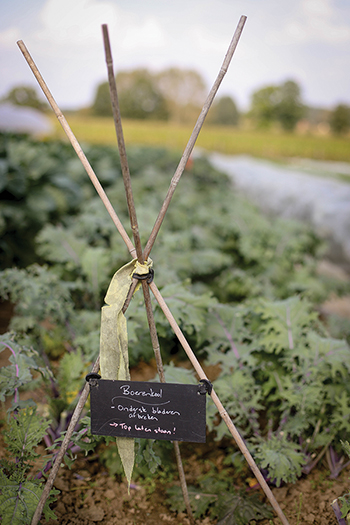 The yellow flag tells members to harvest moderately for fresh use, and the sign says ‘Kale — harvest the lower leaves, LEAVE THE TOP OF THE PLANT.’
The yellow flag tells members to harvest moderately for fresh use, and the sign says ‘Kale — harvest the lower leaves, LEAVE THE TOP OF THE PLANT.’
I love having people come to our field, chatting and seeing their pleasure in the vegetables. I also appreciate how being able to harvest oneself also increases the engagement and investment from our CSA members beyond the financial aspect. They come to understand what it’s like to have to put on rubber boots and warm clothes to come harvest leeks in January.
Our members can harvest year-round. We have a Maritime/Gulf Stream climate similar to the Pacific Northwest, while located higher at Calgary’s latitude. While our three moveable high tunnels help with our winter offering, we also have a variety of crops that simply keep growing in the field through the winter, such as leeks, root crops, Brussels sprouts (of course), kale, Savoy cabbage and radicchio.
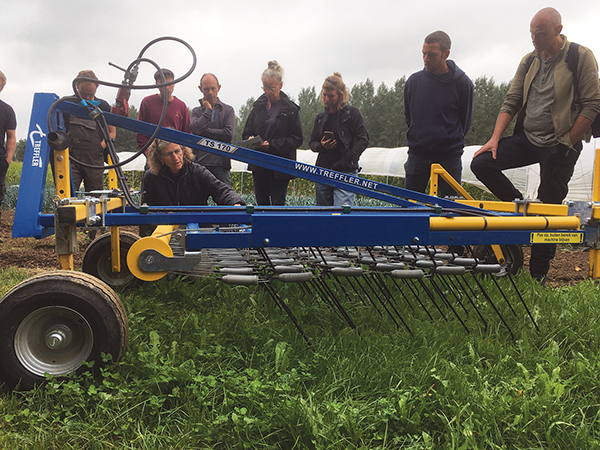 Growers checking out the Treffler tine weeder.
Growers checking out the Treffler tine weeder.
We don’t store any crops in the field; after winter squash have been harvested and counted, we let our members know how many they can take and they pick them up in the field and store them at home. To make self-harvest work, we work with a flag system in the field to indicate where and how members can harvest. Weekly emails provide additional information.
The self-harvesting CSA works on the basis of trust. Everyone who first hears about it swears that it won’t work. But it works. In 10 years we have only had one report of possible theft. Occasionally we discover that someone has harvested something they shouldn’t have but we assume that this is mostly a case of insufficient communication on our part rather than bad intentions.
Harvesters sign up for the entire family and pay per person. This year, each adult pays 400€ (in April that was $435) with a sliding scale possible. Children pay their age times 20€ (just under $22). The entire family is expected to register.
The field is always open. We are often there, but not always. The field is located in a small town, directly off the main street and behind a row of houses. Theft is not an issue.
We do a briefing for new harvesters at the beginning of the season, explaining the whole harvesting system. This includes, for instance, how to harvest ‘cut and come again’ greens or head lettuce. We also send bi-weekly field updates via MailChimp to highlight new crops, perhaps draw attention to something that may need to be corrected, provide recipes and so on.
Harvesters bring their own bags, containers and knives. We provide spades and digging forks. The fields are coded with three flag colors. The yellow flag means ‘Harvest for fresh use,’ blue means ‘Abundance, take a lot and feel free to freeze or can it,’ while the red flag or no flag indicates ‘Don’t harvest.’ We also put little signs under the flags to give more explanation where needed. For instance, in the photo of the sign on the previous page it says, “Kale — harvest the lower leaves, LEAVE THE TOP OF THE PLANT.”
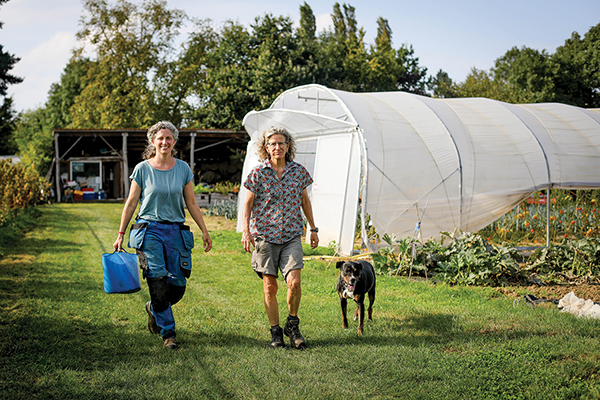 In this picture, the author is on the right and her business partner Anne is on the left.
In this picture, the author is on the right and her business partner Anne is on the left.
Most of the time we don’t stipulate specific amounts. We strive to have enough variety and volume of many vegetables such as lettuce, beans, summer squash, carrots, and so on, so that harvesters can take what they like without having to count or weigh.
However, for single harvest crops such as winter squash (which we harvest together with our members), we do count them and then divide them among all the harvesters. We also work with a limit on crops such as cauliflower and broccoli, as we only plant limited successions of these because they would otherwise take up too much field space.
We work with a six-block rotation of ten 75 meter (250 foot) beds and are strict about not allowing the brassicas to take up more space than allotted. We have had clubroot (Plasmodiophora brassicae) in the past and need to be careful with this in the cole crops. Rotating land out of brassicas helps suppress clubroot. We do double-cropping on some of these beds.
We also grow celery root; red, white and Savoy cabbages; and winter squash on a separate field in collaboration with a colleague CSA farmer who does weekly boxes. We harvest these crops ourselves and bring them to the field to be picked up there — often without a limit.
During initial harvests of very popular crops such as strawberries and tomatoes, we always work with a limit per person. Depending on the year and production, we may continue to work with a weekly limit of tomatoes, which are without a doubt the favorite crop of most harvesters and one of our signature crops, along with sugar snap peas and garlic.
 CSA members Klara and Marijke harvesting.
CSA members Klara and Marijke harvesting.
In the beginning, many new harvesters are uncomfortable with the open nature of how we share the harvest. They wonder: “How do I know how much I can take?” In particular, the yellow flag takes quite some explanation. How much is “Harvest for fresh use?” It depends, of course. Some harvesters come every two weeks and take more. Others come every few days and take less. Some are harvesting for one person, others for a whole family. So, it really depends.
But I believe strongly in the open policy of offering the vegetables. My sense is that the more we can work without a limit, the more people have a sense of abundance and the less they take. When we start having to use more limits (as is sometimes the case at the beginning of the season) occasionally this can create a sense of “there’s not enough, so I’d better make sure I get my share.”
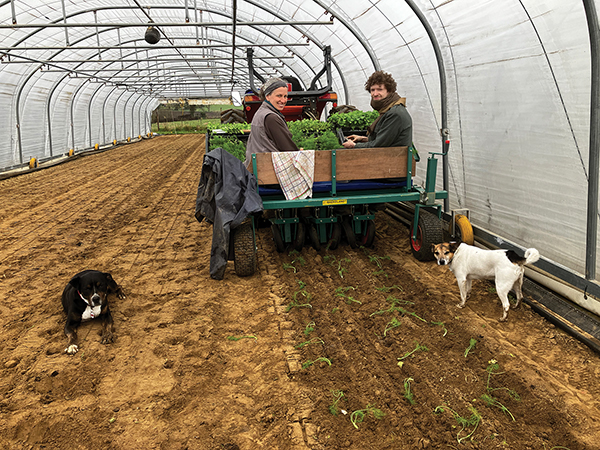 The transplanter is compact enough to be used in a tunnel. All images courtesy of the author.
The transplanter is compact enough to be used in a tunnel. All images courtesy of the author.
So, we try to work as often as possible without a limit and with blue flags. Many CSA discussions emphasize sharing the risk. But I feel it’s very important for harvesters to have the experience of sharing the abundance as well. Within limits, of course.
We do our best to provide ample food for our harvesters. And at some point it’s also enough and just is what it is. Sometimes the limits are created by constraints such as crop rotation or space — as with the cauliflower and broccoli, which harvesters would be happy to eat year-round along with leeks.
We only have winter leeks from November to April. Sometimes it’s a decision on our part to simply not put in more strawberries or tomatoes because of the work involved. Fair enough, if you ask me. This is connected to the issue of taking care of oneself as a farmer. Taking care of our ‘customers’ (we never use this word to describe our members) is important. But taking care of ourselves as farmers is essential.
During the last few years there has been a growing conversation among small-scale, direct sales organic farmers in Belgium about burnout. A colleague, who unfortunately decided to stop this spring, had a coffee cup which read: “It’s easy to start farming, hard to keep farming.”
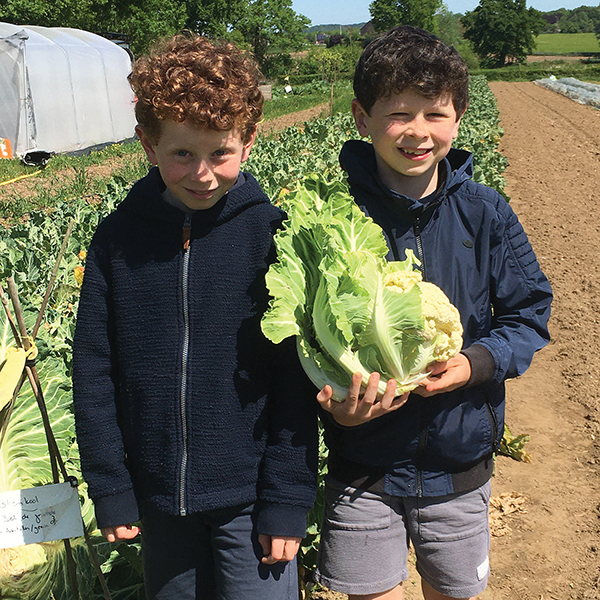 Joppe and Toots with some cauliflower they harvested.
Joppe and Toots with some cauliflower they harvested.
Over-investing, under-investing, we mostly see idealistic farmers burn out from working too many hours for too little pay. We’ve also seen a variety of farmers who hopped on the CSA wagon, half-assuming that it would guarantee a correct income, and they were disappointed when this didn’t happen. In my experience, it’s a great model, but one still needs to be an entrepreneur to make it work.
Inspiration
We have three moveable high tunnels that measure 7 x 36 meters (23 x 118 feet). A few weeks ago we moved one of the tunnels off the winter brassicas (winter radishes, white turnips and pac choi) onto the empty space next to it in order to dry the ground out after the winter. In the meantime, we’ve been able to work the beds several times with our old tine cultivator and in a few days we’ll be planting our seedling order out with our tractor-driven transplanter.
The tunnels were designed to be high and wide enough to be able to use our tractor in them. The original inspiration when we started in 2011 came from Eliot Coleman’s books. I grew up in the United States, though I’ve now lived in Belgium for more than 27 years. Although I left the US before ever dreaming of becoming a farmer, I’ve always kept a close eye on organic vegetable growing there and am regularly inspired by techniques, crops and farmers’ stories.
I was fortunate to find a high tunnel manufacturer who was willing to work with me and this crazy idea of making one of their tunnels moveable (Eliot Coleman in hand). We went through various iterations before settling on the current design which is now becoming increasingly popular among local vegetable growers.
The transplanter was a new addition to our fairly extensive ‘machine-park’, as they call it in Dutch. We were growing about 1 hectare of vegetables at that time, with plans to expand to another field with another ½ hectare.
Small AND mechanized?
We struggled with the question about whether it was justifiable to buy a transplanter for a farm of our size. The machine we had in mind was an adapted version of an older machine, where 3 planting stations had been brought closer to each other, making it possible for 1 person to fill 2 or even 3 stations (in the past the stations were farther apart, requiring 1 person per station to plant).
Various elements played a role for us in our decision to buy the planting machine.
• I’m 61 (started farming at the age of 50) and my farm partner, Anne, is 41. From the beginning I’ve been interested in mechanization, wanting to be able to physically do this job until retirement.
• We have easy, cheap access to young seedlings in Belgium and had tended over the years to favor planting seedlings rather than direct sowing in many situations.
• We recognized how physically taxing it was to drag flats of seedlings along our 75 meter (250 foot) long beds when planting.
• We have two CSA colleagues 2-5 kilometers from us who were interested in sharing the machine, which would not need to be available for daily use.
• We were convinced that the planting machine would be a huge time-saver and calculated that it would be cheaper to budget for the annual depreciation than to pay for extra labor.
It’s been a game changer for us.
Plants are planted quickly, ergonomically, in straight rows into clean beds and are very well anchored in the ground, which has proven to be helpful in a dry year. We even managed to adapt the machine for direct seeding our winter squash and fava beans. Work that once took us a full day on hands and knees, dragging trays along with us, now takes us a couple of hours. Harvesters or visitors to the field often hop up onto the bench to plant with us, delighted in the result.
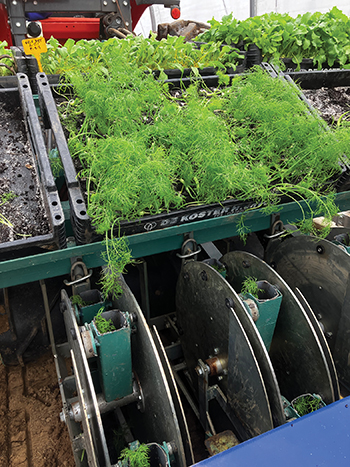 The transplanter showing the planting stations that were made closer together
The transplanter showing the planting stations that were made closer together
so fewer people could operate it.
We have a network of CSA farmers in Flanders (www.csa-netwerk.be, where certified organic is a membership requirement) and also a strong organic umbrella organization (BioForum), both of which organize farmer get-togethers throughout the year. Another advantage of living and farming in a compact country. More and more discussions explore issues such as self-care. How do we keep farming for the long-term? What does self-care look like?
For some farmers, mindfulness has been extremely helpful, as have discussions with colleagues about daring to set a ‘correct’ price. We’ve also had great discussions about Ben Hartman’s ‘Lean Farming’ concepts. In addition to taking part in such open discussions and being challenged to question some of our assumptions, daring to invest and mechanize have been key to reducing our stress and helping to limit the hours we spend farming. Much as we love farming, we also love our families.
Sometimes it’s been larger investments, such as the Treffler tine harrow, and planting machine, which are especially significant as they can be used in most of our crops. But it’s also the small things, such as the quick hitches for all of our machines, which makes it possible to switch machines without getting off the tractor. Or starting to use the Qlipr® system for trellising our high tunnel tomatoes and cucumbers.
I believe strongly in the value of talking about this issue — questioning, challenging and inspiring one another. We hosted a farmers’ get-together last year about working with the Treffler tine harrow and strikingly when we asked why people had come, the primary reason was “I work too much.” We’re all organic farmers mostly working on two hectares or less and 18 farmers ended up joining in afterwards for a group order. So exciting to see so many farmers choosing to take care of their vegetables and themselves.
Since last year, I have a partner, Anne, who runs the farm with me. Two women farmers, which is cause for confusion and humor because in Dutch the word for farmer ‘boer’ is both generic and male. ‘Boerin’ is the word for a female farmer or the farmer’s wife. I once introduced myself to a school group as the ‘boer.’ They were quick to correct me: “No, you’re the ‘boerin.’” Next time around, I introduced myself as the ‘boerin.’ The immediate reply: “Where’s the ‘Boer’?”
Whatever you call us, sometimes it’s an interesting position, being a woman farmer, especially one who likes machines. Gaining credibility among farming colleagues and suppliers has taken some time, but other farmers are always curious about the specialized machines we use for our organic vegetable production. Most other farms in the area grow grain, corn or sugar beets.
I think our farms reflect who we are as people. I tend to get irritated by inefficient work. While I can enjoy hanging out, I hate wasting time. I also like having a clean field, which our harvesters also appreciate.
These traits combined last year into the choice to invest in a Treffler precision tine harrow. While I love using my favorite Dutch hoe for cultivating (virtually unknown in the US, I think - so interesting, the different ‘tool cultures’ which develop in different places), I am aware that hand weeding is slower and asks more from my body than mechanical weeding.
We had worked with an older flex tine harrow in the past, and while we could see that it did help reduce our weed pressure, it was limited in its adjustability and thus in its usefulness. It ended up standing on the side of the field for most of the season.
We had been hearing about the Treffler for several years and had observed them in action on a colleague’s farm and also at the large organic trial center in Belgium. Last year we decided to take the step and invest again and we haven’t looked back since.
Last season was a challenging season for us. After two very dry summers, with very low weed pressure and lots of irrigation, we had a “typical Belgian summer:” cool and wet. Every ten days or so we had one or two days where it was dry enough to be able to do something with our weeds and then had limited time in which to do so because it was going to rain again. So we had about 1.5 hectares (almost four acres) of vegetables which we needed to cultivate in a very short time. This cycle kept repeating itself for most of the very demanding summer.
Time and again, we counted our blessings that we had decided to invest in the Treffler. Starting about one week after planting we worked most of our beds every 10 days or so throughout the season and managed to keep most of our field quite clean, despite the challenging season. Some crops could only be worked for a couple of weeks before they started to grow too broad to be worked (lettuce, radicchio, some cabbages), others could be worked the entire season (celeriac, fennel, celery, kohlrabi…). Even our winter squash could be worked surprisingly long with the Treffler.
It was a year of experimenting and getting to know the new machine. Sometimes we were too rough and pulled some plants out or damaged too many leaves. Sometimes we were too soft and didn’t actually have much impact on the germinating weeds. But that’s how we learn, isn’t it? With the hydraulic adjustment of the tine tension, it was easy to correct after the first couple of meters.
Jen Nold runs CSA De Witte Beek together with her work-partner, Anne, in Bierbeek, Belgium. Jen grew up in Colorado and worked for Outward Bound for many years. She met her Flemish husband while working in South Africa, moved to Belgium and learned Flemish. After ten years working for Outward Bound Belgium, she made a career switch by taking a two year organic farming program and started De Witte Beek in 2012. She’s never looked back.
